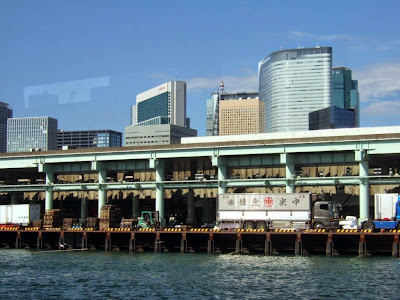
In 16th century, Tokyo Bay was known as Edo Bay. The present name was applied when the city's named changed to Tokyo in 1870s after the Imperial Court moved from Kyoto to here. The whole area located in southern Kanto region covers the coasts of Tokyo, Kawagawa and Chiba Prefecture. There are numerous rivers empty into Tokyo Bay which is connected by Uraya Channel to Pacific Ocean. Tokyo Bay provides all water supplies for residential and industrial areas along the coasts. It is the most prosperous and largest industrial area in Japan. The most imposing structures along the bay are Tokyo Skytree and Asahi Beer Tower with its characteristic Flame D'or structure. The complex of Asahi Super Dry Hall hosting the headquarter of Ashai Breweries and several restaurants, is completed in year 1989. The present site area of Tokyo Bay has included 249 sq. kilometer of reclaimed land.



One of the convenient way to have a glimpse of Tokyo Bay is by water bus. Ticket can be obtained from the station from an auto machine near Asakusa area. Boarding pier lies just next to it. The lovely blessing plague that carries the wish for its guests to have a safe drive on water, was hanged in the waiting room of the ticketing office .



Sumida River flows through Tokyo for 27km.


Prices of properties along Sumida River are one of the highest on earth.


Sky-scrappers along Sumida River.


There are 26 bridges crossing over Sumida River with various features and designs. Most of them were originally built within 16th to 17th century but replaced in early 20th century.














Tokyo Bay is a rich center of fishing industries. Nihonbashi Fish Market was the first fish market, established by Tokugawa Ieyasu in Edo period to supply food for Edo Castle which is now the Tokyo area.


Nihonbashi Fish Market after destroyed in 1923 earthquake was relocated to Tsukiji District and renamed as Tsukiji Fish Market, which is now the biggest wholesale fish and seafood markets of any kind in the world.


Tsukiji Fish Market located between Sumida River and the famous Ginza Shopping Districts. Market has two sections. The Inner section where the 900 licensed wholesale dealers operating their stalls, and where tons of tuna auction took place, is restricted for visitors. It allows only 120 visitors a day within 5am to 6am in the morning to watch the proceedings from a designated area, basing on first-come-first-serve basic. The section opened at 3am when products begin to arrive from all parts of the world by plane, by ship or by trucks. The auction starts at 5.20 am and end at 7am. All activities declined after 8.00am.


Some wholesalers and most retailers who sell kitchen tools, restaurant supplies, groceries are in the outer section with many sushi restaurants. The section is closed in early afternoon, slightly later than the inner section. Tsukiji Fish Market remains a major tourist attraction for its locals as well as its oversea guests.


The red structure at the far distance, is Tokyo Tower which appears mini in size now compared to newly built Skytree. It was the tallest building when I first time visited Tokyo years back.



Some of the beautiful bridges.






There are many five stars hotels and expensive restaurants along Sumida River.




Tokyo twin towers follow the concept of KL Twin Towers in Malaysia, with a connecting bridge between the two buildings.






Sumida-gawa River in Chuo-ku is one of the stop of water bus as it is one of the entrances to go into Hama-Rikyu Imperial gifted Garden.


No comments:
Post a Comment